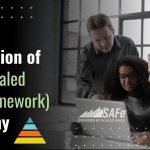Read this detailed SAFe certification guide to know which SAFe course is best for you, the benefits of SAFe certification, what is SAFe Agile Framework, top SAFe certifications in 2025, and a lot more.
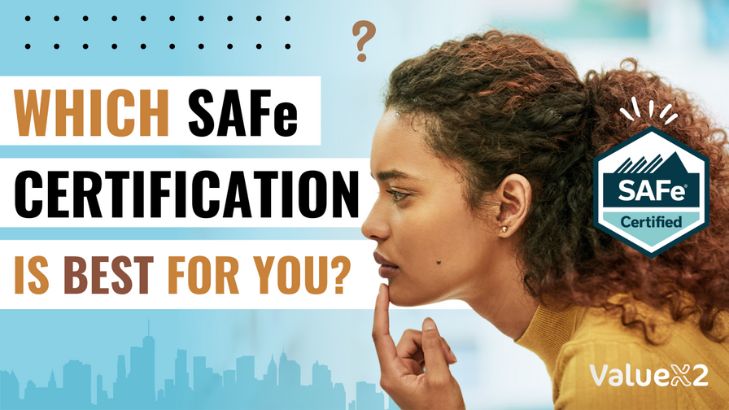
Introduction
Businesses should adapt to changes and strongly focus on being competitive in today’s digital world. With a stronger focus on agility, organizations have gained strength and deliver good products, within less time. There are numerous Agile frameworks out there, one of the most effective models that appeared through time is called Scaled Agile Framework, or SAFe, created specifically to address the necessity for spreading Agile beyond one team.
However, since there are several SAFe certifications within the market, it can be difficult to figure out what SAFe certification is most suitable for you. In this article, we will discover some of the best SAFe certifications for 2024 and will establish which of these courses matches the career progression.
What is the Importance of Agile Scaling Frameworks?
To improve large successful projects, which often involve many teams working simultaneously, there is a need for frameworks such as Agile scaling frameworks like SAFe.
While traditional principles of agility often address a single organization team, such as Scrum, the scaling frameworks, including SAFe, address organizational strategies and planning, as well as implementation and operation.
Here’s why Agile scaling frameworks, especially SAFe, have gained importance:
- Enhanced Coordination: SAFe brings inter-team cohesion under the umbrella of a shared vision of a strategy to ensure that the different teams are on the same page.
- Consistent Delivery: Agile scaling frameworks help in maintaining a standard in what teams in the company do, through the practice of synchronizing organizational goals across departments.
- Adaptability: Such frameworks align well on a massive scale with Agile principles as a mechanism to provide the necessary elasticity to meet the needs of the market and customers.
- Customer-Centric Focus: The scaling frameworks also adopt the concept of customer involvement alongside the process of continually delivering small, incrementally developed products to meet the market’s needs and standards.
Companies are now using SAFe widely as an approach to scaling Agile successfully; thus, the demand for a leading SAFe certification increases.
Advantages of Agile Product Management
Agile product management incorporates the development of the product in cycles that are served by constant communication with stakeholders, and quicker response to customer feedback. This works well when it is done on a large scale through SAFe as it makes Agile work across the organization levels. Here are the key advantages:
- Increased Efficiency: Agile product management enables teams to be more productive by avoiding the risk of giant leaps and focusing on constant improvements. This leads to faster delivery and also flexibility to change an approach as per the feedback received.
- Better Stakeholder Collaboration: Unlike a more traditional approach to product management, Agile product management incorporates stakeholders across the development cycle to ensure that the product planned and produced is a strategic asset to the business and the customer.
- Enhanced Flexibility and Adaptability: The flexible methodologies can easily adapt to new information from the customers or other factors that define the product delivery marketplace so that the final product being delivered is still relevant in the marketplace.
- Faster Time-to-Market: This approach is utilized because agile teams operate in sprint releases and frequently small updates/features so that the time-to-market is much shorter. This is particularly important in such industries to afford a competitive advantage for being faster in service provision.
What is Business Agility?
Business Agility is a people-centred, organization-wide capability that enables a business to deliver customer value rapidly, innovatively and creatively while swiftly responding to external changes.
Business Agility is a top priority for businesses globally. This is highlighted across several recent surveys for instance:
- McKinsey Global Survey: 90% of C-suite executives indicate that organizational agility is critical to business success.
- The Business Agility Institute’s Annual Survey: It was found that over 70% of companies globally now prioritize agility when making business decisions.
- Forbes Insights Report: “Agility” was listed as the top success factor impacting performance by business leaders.
What is SAFe Agile Framework?
Business agility is achieved when we scale the practices and tools across all teams involved in delivering customer value. There are many Scaling Frameworks that an organization can use for scaling agility to teams and wider organizations.
The top 5 scaling frameworks are:
- Scaled Agile Framework (SAFe)
- Scrum of Scrums / Scrum@Scale
- Spotify Model
- Disciplined Agile (DA)
- Large Scale Scrum (Less)
(mentioned in no particular order)
According to the 17th State of Agile report, the Scaled Agile Framework (SAFe) is the most popular Scaling Framework.
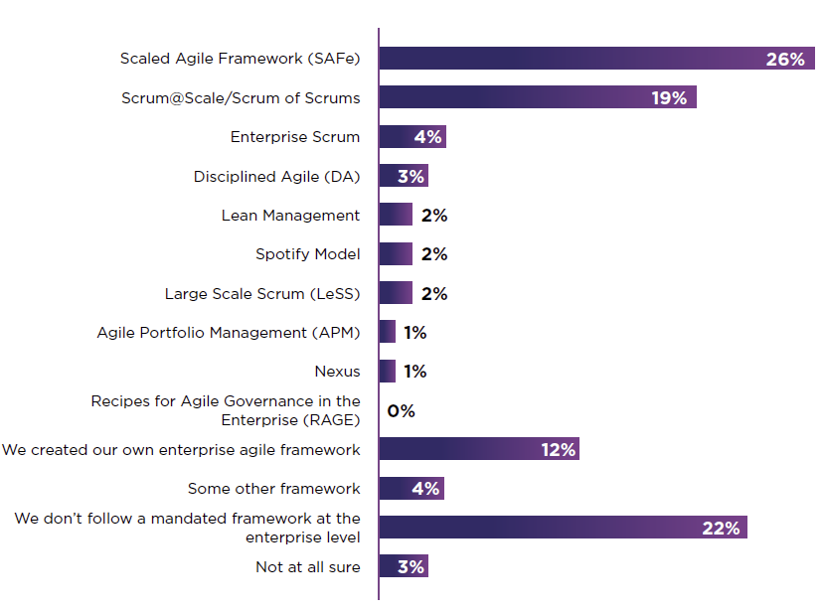
The SAFe 5.0/SAFe 5.1 version has been revised to SAFe 6.0 in 2023. Scaled Agile Framework is built using the knowledge bodies of Agile, Lean, System Thinking and DevOps.
Below is the Big Picture for SAFe that shows what four levels of Scaled Agile Framework configurations are possible:
- Essential SAFe Configuration
- Large Solution SAFe Configuration
- Portfolio SAFe Configuration and
- Full SAFe Configuration
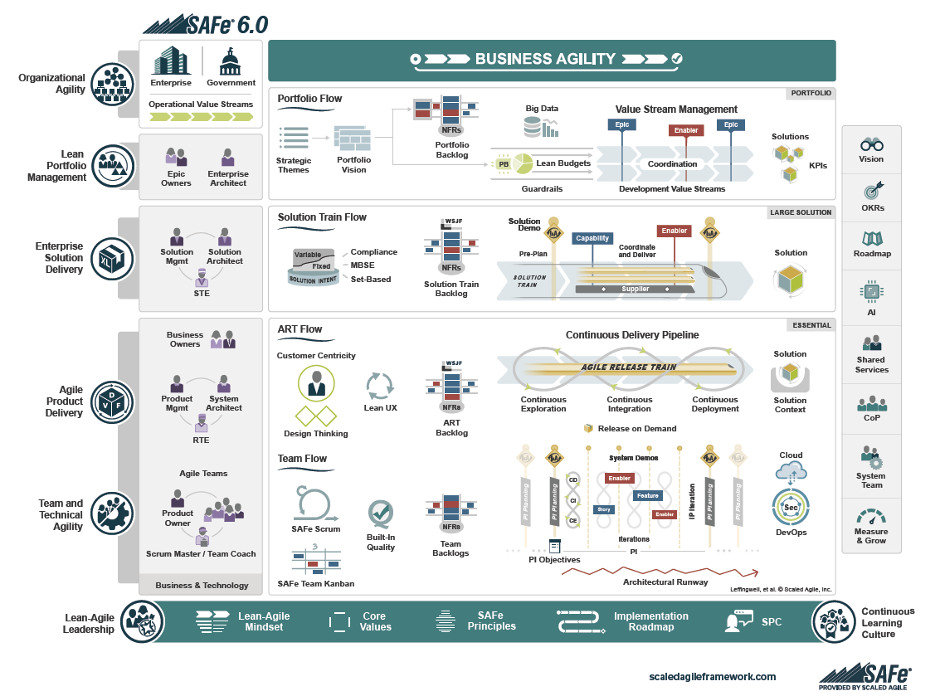
Scaled Agile Framework is underpinned by 4 core values. The 4 Scaled Agile Framework Core Values are:
- Alignment
- Transparency
- Respect for People
- Relentless Improvement
These are the foundational beliefs that drive the culture and lead to successful SAFe implementation.
What are the 4 top key benefits of Implementing SAFe Scaled Agile Framework?
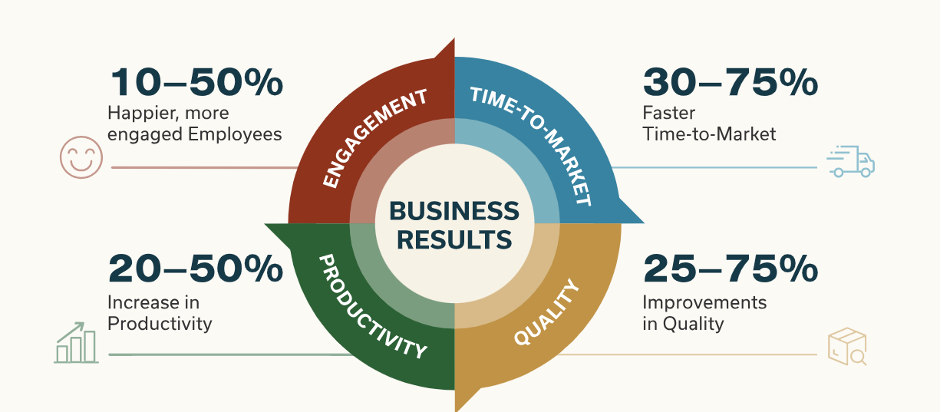
Source: Scaled Agile Inc.
SAFe has aggregated the data from various case studies showcasing the 4 benefits of SAFe Agile implementation:
- Faster Time-to-market
- Improvements in Quality
- Increase in Productivity
- Better Employee Engagement
Is SAFe Certification worth it?
Globally there are more than 1,000,000 SAFe practitioners and 20,000 enterprises that have leveraged the Scaled Agile Framework® (SAFe®). The SAFe framework is used across several industry sectors.
This wide and ever-increasing adoption definitely makes it worth getting SAFe certification. Taking a SAFe course and earning a certification are the first steps toward jump-starting your career in the Agile space.
According to Gartner SAFe is the no.1 most considered and adopted framework for scaling Agility.
According to SAFe Careers Snapshop 2024 report, over 1.4 million people have received the SAFe training! Clearly, that number shows the increasing demand and popularity of the SAFe certifications.
The report also highlights that in December 2023 a poll of SAFe professionals found that 100% of respondents plan to seek opportunities with companies using SAFe in the future.
What are the top 10 benefits of doing SAFe Certification in 2025
SAFe is a Framework to scale agility across the enterprise and ultimately achieve Business Agility. This transformation of the organization requires a strong change leadership and a culture that embodies Lean-Agile Mindset.
The top 10 reasons to pursue a SAFe certification are:
- Globally recognized and preferred certification
- Credible certification for career progression recognized by employers worldwide
- Most sought certification in job descriptions by companies deploying SAFe Framework
- SAFe certifications are versatile and scalable
- Higher salary potential
- Increased reach within the community
- Adds value to the resume
- SAFe Certification equips one to respond to complex problems
- SAFe certification helps implement the lean-agile approach
- Helps improve decision-making and problem-solving skills
Top SAFe Certifications in 2025
The SAFe Implementation Roadmap describes the critical steps an organization can take to implement the SAFe Agile Framework in a logical, reliable and successful manner. Each Stage highlights the suggested SAFe certification for the employees of the company.
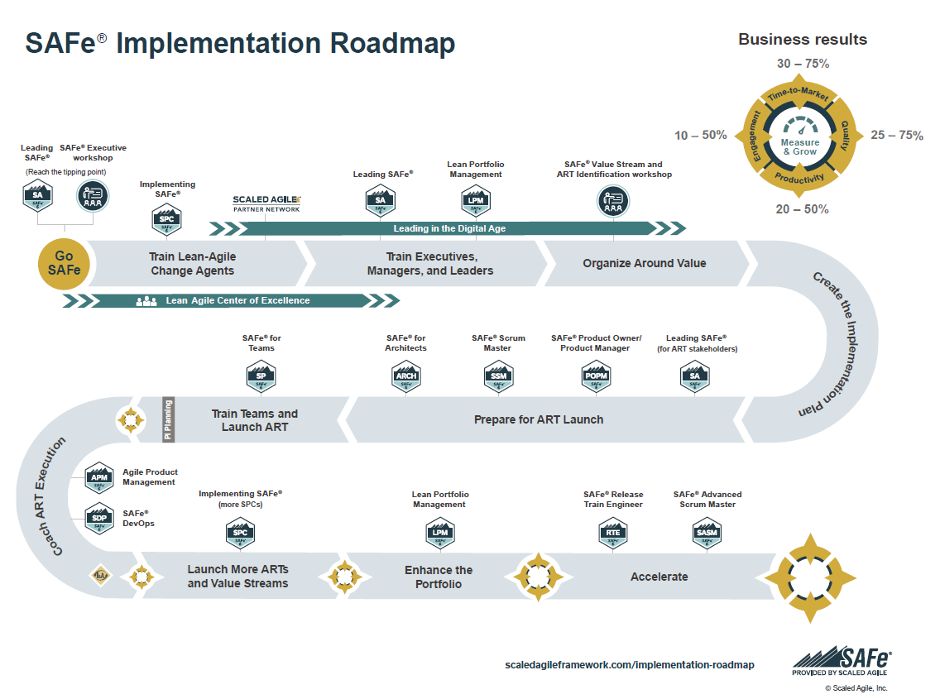
SAFe Implementation Roadmap
To understand What is SAFe Certification? Below we explain the best SAFe certifications and SAFe courses offered by Scaled Agile for you. Let’s understand by going through each of the SAFe® certifications in detail in the below table.
| Top SAFe Certifications in 2024 | ||
| SAFe Certification Training | Course Overview | SAFe Certification |
| Leading SAFe® (SA) | Thriving in the Digital Age with Business Agility | Certified SAFe® Agilist (SA) |
| SAFe® Product Owner/Product Manager (POPM) | Delivering Value through Effective Planning Interval Execution | Certified SAFe® Product Owner/Product Manager (POPM) |
| SAFe® Scrum Master (SSM) | Applying the Scrum Master Role within a SAFe Enterprise | Certified SAFe® Scrum Master (SSM) |
| SAFe® for Teams (SP) | Establishing Team Agility for Agile Release Trains | Certified SAFe® Practitioner (SP) |
| SAFe® Release Train Engineer (RTE) | Facilitating Lean-Agile Execution from Agile Release Trains | Certified SAFe® Release Train Engineer (RTE) |
| SAFe® Advanced Scrum Master (SASM) | Advancing Scrum Master Servant Leadership with SAFe | Certified SAFe® Advanced Scrum Master (SASM) |
| SAFe® DevOps (SDP) | Optimizing Your Value Stream | Certified SAFe® DevOps Practitioner (SDP) |
| SAFe® for Architects (ARCH) | Architecting for Continuous Value Flow with SAFe | Certified SAFe® Architect (ARCH) |
| Agile Product Management (APM) | Using Design Thinking to Create Value Products in the Lean Enterprise | Certified SAFe® Agile Product Manager (APM) |
| Implementing SAFe® (SPC) | Achieving Business Agility with the Scaled Agile Framework | SAFe Practice Consultant (SPC) |
| Lean Portfolio Management (LPM) | Aligning Strategy with Execution | Certified SAFe® Lean Portfolio Manager |
Leading SAFe 6.0 Training with SAFe Agilist Certification
The Leading SAFe® 6.0 (Previously known as Leading SAFe® 5.1) Training to SAFe® Agilist certification is the best course for introduction to SAFe Framework. It gives an overall understanding of all the core values and principles of SAFe®. This course helps understand business agility and the 7 competencies organizations must master to achieve Business Agility.
This includes a PI Planning simulation. The attendees will also learn Portfolio SAFe® and Critical ART Success Factors. Focused on the behaviours of leaders in the SAFe® Implementation process, this course is helpful for leaders, managers, coaches, and executives who want to play an active role in SAFe® implementation in the organization.
Choosing the Right SAFe Certification – Which SAFe certification is the best?
Now that we know which are the various SAFe Certifications, the next obvious question is which is the best SAFe certification for me that supports my Career Development.
The SAFe Careers Snapshop Report 2025 highlights that most companies who use SAFe require at least one SAFe certification, and many prefer multiple certifications as one progresses in their career and role. Given SAFe certifications are adaptable and scalable, these apply to multiple roles, and in several cases, they significantly increase employability and earning potential.
3 Key questions to consider before choosing the right SAFe certification for you are:
- What is your role within the organization?
- What is the goal of the SAFe certification?
- What experience level are you with SAFe?
We demystify the above for you below in a simple table:
| What is your role within the organization? | Scrum Master/Team Coach | Product Owner/Product Manager | Agile Team |
| Guides and champions the Agile and Lean Ways of working. “How is the Product Developed?” | Owns the product Vision and is the voice of the Customer. “What Product is developed?” | Has the technical competence to develop the product | |
| The goal of the SAFe certification | Certifications are taken to enhance your Servant Leadership Skills as a Scrum Master | Certifications are taken to broaden your agile product development and techniques | Certifications are taken to enhance technical skills to build high-quality products |
| Core Certifications for Beginners | Leading SAFe® (SA) | Leading SAFe® (SA) | Leading SAFe® (SA) |
| Speciality Role Certifications for Intermediate Level | SAFe® Scrum Master (SSM) | SAFe Product Owner/Product Manager (POPM) | SAFe® for Teams (SP) |
| SAFe® Advanced Scrum Master (SASM) | Agile Product Management (APM) | ||
| Advanced Certifications for Expert Level | SAFe® Release Train Engineer (RTE) | Lean Portfolio Management (LPM) | Lean Portfolio Management (LPM) |
| Lean Portfolio Management (LPM) | |||
| Implementing SAFe® (SPC) | Implementing SAFe® (SPC) | Implementing SAFe® (SPC) | |
| Technical Certifications | Certified SAFe® Architect (ARCH) | ||
| SAFe® DevOps (SDP) |
These equip the SAFe participants and professionals in every SAFe role and through every stage of their learning journey.
As a SAFe training provider, ValueX2 makes It simple for you to become SAFe certified, Enrol and Attend SAFe training, Learn, study, practice and pass the exam and get SAFe Certified.
Conclusion
We hope the above in-depth article helps you make a wise choice. Good luck! If you have any questions don’t hesitate to contact us at info@valueX2.com.
Frequently Asked Questions (FAQs)
Q. Which is the best SAFe certification?
Ans. The primary criterion for selecting the best SAFe certification in 2025 is your responsibilities and objectives in Agile environments. For those aspiring to be change agents, the Leading SAFe Certification (SAFe Agilist) should be considered since it gives a competitive understanding of SAFe.
If one wants to advance further, he or she may opt for a certified SAFe Scrum Master or SAFe Product Owner for given Agile positions.
Q. How many SAFe certifications are there?
Ans. There are 13 primary SAFe certifications one can get in 2025. These range from SAFe for the Agilist for those who want to understand the basics to more advanced courses like SAFe Release Train Engineer and SAFe Advanced Scrum Master.
All the certifications are issued at various levels of experience and responsibility to work with Agile processes and enable professionals to focus on specific fields.
Q. What is the basic SAFe certification?
Ans. SAFe Agilist is most often called the basic SAFe Certification and is the most delivered SAFe certification. It lays the basic framework that is applicable across the various dimensions of SAFe and is therefore useful to the newcomer to SAFe.
This certification ensures that an individual is ready to be productive in regards to SAFe and is the first certification anyone who wants to work with the SAFe Agile frameworks takes.
Q. Which SAFe certification is best for project management?
Ans. In project management, it is helpful to be a SAFe Program Consultant (SPC) or SAFe Release Train Engineer (RTE). These certifications are about administering and leading Agile Release Trains so they can be considered as among the best SAFe agile certifications to get in 2025 for the positions of project management.
Q. Is SAFe better than Scrum?
Ans. SAFe and Scrum are fundamentally different; SAFe is aimed at Agility in large organizations, and Scrum is employed at the team level. For organizations that require consistency across various teams and departments, it is easy with SAFe.
However, Scrum is easier to maintain in a number of small or agile teams where face-to-face communication is possible, and teams are capable of making iterations in a very short time. Each has its strengths and weaknesses, based on the size and purpose of the work accomplished.
Q. Which SAFe certification is best for business analysts?
Ans. For Business Analyst, it is advised to pass SAFe Product Owner/Product Manager as this profile is oriented on product development and management. This skill empowers analysts with how to work smart and focus on items of more value, effectively build highly understandable product backlogs, and control stakeholders.
Q. How long is SAFe 6.0 valid for?
Ans. SAFe 6.0 certifications achieve recognition for one year from the moment the proper completion takes place. After this, certified professionals must reinstate the credentials every year, by paying for the renewal fee and satisfying all requirements of the ongoing professional development.
To achieve and sustain certification, SAFe practitioners will remain relevant as they keep themselves updated with the latest Agile and SAFe practices.

Bhavna is an Agile Coach and Consultant with over a decade of experience in advisory, corporate finance, IT assurance, and operations at Big 4 and within the industry in the UK and India. She has recently been the CEO of a start-up where she implemented agile practices within HR, Marketing, and Product teams.
She is also a SAFe® Practice Consultant (SPC) and authorized instructor for ICAgile Agility in HR (ICP-AHR), Agility in Marketing (ICP-MKG), and Business Agility Foundations (ICP – BAF) training courses. She provides training for agile transformation to corporate, public, and private batches, as well as consulting for enterprise agile transformation.




